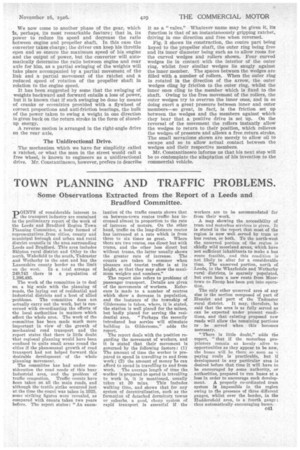TOWN PLANNING AND TRAFFIC PROBLEMS.
Page 63

If you've noticed an error in this article please click here to report it so we can fix it.
Some Observations Extracted from the Report of a Leeds and Bradford Committee.
"DOINTS of considerable interest to the transport industry are contained in the preliminary report of the work of the Leeds and Bradford Region Town Planning Committee, a body formed of representatives from cities, county and municipal borough and urban and rural district councils in the area surrounding Leeds and Bradford. This area includes Skipton rural district and Otley to the north, Wakefield to thc south Tadcaster and Wetherby to the cast and has the Lancashire county border as the limit on the west. In a total acreage of 249,743 there is a population of 1,266,495.
The work of the committee.is to deal on a big scale with the planning of roads, the laying out of residential and industrial districts and a host of allied problems. The committee does not actually carry out the work, but is concerned with co-ordinating the efforts of the local authorities in matters which affect the whole area. The work of the committee has been made much more important in view of the growth of mechanical road transport and the report states that there is little doubt that regional planning would have been confined to quite small areas round the cities if the phenomenal growth of road transport had not helped forward this desirable development of the whole planning movement.
The committee has had under consideration the road needs of this busy industrial area, and the problem of
traffic congestion. Traffic counts have been taken on all the main roads, and although the textile strike occurred just at the time the count was taken in 1925, some striking figures were revealed, as compared with counts taken two years before. The report states: "An exam
ination of the traffic counts shows that on between-town routes traffic has increased almost in proportion to the rate of increase of motors. On the other hand, traffic on the long-distance routes has increased at a rate which is from three to six times as great. Where there are two routes, one direct but with trams, and the other less direct but without trams, the latter usually shows the greater rate of increase. The counts are taken in summer when pleasure and tourist traffic is at its height, so that they may show the maximum weights and numbers."
The report also refers to problems of passenger transport. Details are given of the movements of workers. Reference is made to a number of centres which show a decrease in population, and the instance of the township of Gildersome is taken, where, it is stated, the station is well placed for the mines, but badly placed for serving the resi dential area. "Perhaps the recently introduced bus service will stimulate building in Gildersome," adds the report.
The report deals with the position regarding the movement of workers, and it is stated that their movement is governed by the following factors : (1)` The amount of time the worker is prepared to spend in travelling to and from work; (2) the amount of money Be can afford to spend in travelling to and from work. The average length of time the worker is prepared to spend in travelling to work is, it is mentioned, usually taken at 30 mins. This includes walking time, and shows that for any system of decentralization, such as the formation of detached dormitory towns or suburbs, a good, cheap system of rapid transport is essential if the
workers are to be accommodated for from their work.
. A map showing the accessibility of tram and motorbus services is given. It is stated in the report that most of the region is now well served by tram or bus routes, or both. To the north-west the unserved portion of the region is chiefly wild moorland areas, which have not sufficient inhabitants to make a bus route feasible, and this condition is not likely to alter for a considerable time. The unserved portion, north of Leeds, in the Wharfedale and Wetherby rural districts, is sparsely populated, but even here a new route from Moortown to Eccup has been put into operation.
The only other unserved area Of any size is the section composed of part of Ennslet and part of the Tadeaster
rural district. It may, therefore, be said that the area is as fully served as can be expected under present conditions, and that existing proposed new roads will allow the remaining portions to be served when this becomes necessary.
"There is little doubt," adds the report, "that if the motorbu.s proprietors remain as keenly alive to opportunities as they appear to be now, the buses will be there so soon as a paying route is practicable, but if development in any particular area is desired before that time it will have to be encouraged by some authority, or authorities, prepared to run buses at a loss in order to encourage such development. A properly co-ordinated tram system is impossible in the region owing to the presence of three different gauges, whilst over the border, in the Huddersfield area, is a fourth gauge; thus automatically encouraging buses.












































































































